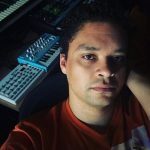Academy Dashboard › Forum › Production › Digital Recording › Sample Rate Debate
- This topic has 15 replies, 13 voices, and was last updated 8 years ago by
 Mark Warner.
Mark Warner.
-
AuthorPosts
-
January 18, 2016 at 7:59 pm #2972
 Andrew MckenzieParticipant
Andrew MckenzieParticipantHi all, seeing there was no love for the Digital Recording topic yet....I thought I would start a topic that might spark some healthy debate over something I have always been curious about in terms of digital recording......
What's the "real" difference in recording sample rates and what rate is needed/optimal (and used) in most DAWs and why?
I found an excellent article online that really opened my eyes (and ears) to the real differences around digital sample rates and I'll link it right here: http://people.xiph.org/~xiphmont/demo/neil-young.html
Also referenced in this article from another great production resource: http://productionadvice.co.uk/high-sample-rates-make-your-music-sound-worse/
Now the question remains.....what sample rate do we really need to be recording at to get the most beneficial results?
I see the marketing push for recording at 192Khz but really wonder what benefits could be made from doing this? I use 44.1Khz by default in Reason (I could go up to 96 if required) and I find it great for reduced file size, CPU overhead and general audio work.
What rates do you use and why?
Cheers....Andrew
January 22, 2016 at 11:33 am #3151 Mdjagg
Mdjagg
192 all the way, if you don't mind the excess file size and you have the processing power and HardDrive transfer rate. I hear a difference between the different sample rates, and to be honest, my system runs better at 192. In my opinion, if mastering engineers want it, why wouldn't I. Common sense to me says the more information plugins can use to analyze audio (points of measurements) and then alter that audio, the better. So 192 has significantly more data points than 44.1. I do agree that we may not be able to "hear" the difference, but the computer knows the difference, and I think that affects your final bounce that ends up in someone's mp3 player. Just my opinion.
-
This reply was modified 8 years ago by
 Mdjagg.
Mdjagg.
January 23, 2016 at 5:10 pm #3187 John DragichParticipant
John DragichParticipantamacca,
There is a plug-in in PT called "MasterMeter" (MM). When inserted last on the
Master Fader track it provides some info on digital overs (clip events). MM
supposedly emulates the processes in music players (CD players, mp3 players, etc.)
used to reconstruct the analog waveform from the digital samples. Hence, it
will let one know if there is inter-sample clipping in the final mix. In my
experience, the reconstructed waveform can have levels up to .5 db higher than
the highest 44.1 volume level. So if you mix at 44.1 near the digital limit,
but not over, it is possible there will quite a few clips when played back on
some music players. With higher sample rates, there will be less inter-sample
overs.Now you could just avoid all this and mix at lower fader levels. Then have your
mix professionally mastered. But if you want your 44.1 mix to sound as loud as
possible without inter-sample clips, then a higher sample rate can help.Hope this is useful.
January 24, 2016 at 1:33 pm #3221 Magnus JohanssonParticipant
Magnus JohanssonParticipantI´m all for xiphmont when it comes to delivering format. Everybody with the slightest of interest should watch the movie that you find on the top of the page that Amacca linked to. http://people.xiph.org/~xiphmont/demo/neil-young.html The article, indeed interesting, is kind of lengthy to read. The video is 24 minutes well spent.
January 25, 2016 at 5:03 pm #3273 Andrew MckenzieParticipant
Andrew MckenzieParticipantThanks for the feedback guys, I reckon I will move to 48k as a standard and see how that goes but I'm not sure I have the processing power to go much higher without investing in a HD system etc.
Cheers...Andrew
-
This reply was modified 8 years ago by
 Andrew Mckenzie.
Andrew Mckenzie.
January 26, 2016 at 12:01 pm #3339 Steve AParticipant
Steve AParticipant24/44.1 here, and I see no reason to use anything else if I'm getting the results that I want.
Well, now using 48k to import Warren's multitracks.. but that's a different situation...And yes indeed, that video is time well spent.
So is reading the article in the second link.
Another article (PDF) worth reading:
http://www.lavryengineering.com/pdfs/lavry-white-paper-the_optimal_sample_rate_for_quality_audio.pdfJanuary 29, 2016 at 6:25 am #3575 Victor CiampiniParticipant
Victor CiampiniParticipantHi guys, I found 96K to sound a little fuller, definitely smoother in the highs, and just seemed to have more body and life than 44K. I know the human ear cannot hear above 20K (or probably 17/18 for most of us) so 44K sb enough, but perhaps there are frequencies outside our hearing range that our bodies can sense, and maybe this is the elusive body/depth that some think is missing from digital recordings? Its a great debating topic for sure!
Cheers
Vic
January 29, 2016 at 3:37 pm #3615 timmymacParticipant
timmymacParticipant@vic - yes you're on to something about frequencies we don't hear. Rupert Neve has the same theory and discussed this at a Skype talk of his that I attended. Maybe there's a YouTube video of his talk...I'll have to look.
I've been tracking at 96 lately. Can't say I really notice a difference. Will have to try 192! ?January 30, 2016 at 11:37 am #3646 timmymacParticipant
timmymacParticipantHere you go. Around 50 minute mark he starts talking about it.
http://youtu.be/SsgQcyXyzssJanuary 31, 2016 at 3:03 am #3656 Magnus JohanssonParticipant
Magnus JohanssonParticipantCheck https://xiph.org/video/vid1.shtml between 11:18 and 13:13. A technical description on why higher samplerates are preferable. As I get it. This is how modern AD:s work. With under the hood higher samplerates, digitally lowpassed and downsampled to whatever samplerate you have chosen. Makes alot more sense to me than why higher samplerates should effect anything audible. Maybe I will get convinced once I get a better DA. This though.. (off topic) http://www.essentialsound.com/essence-power-cord/ Somebody laughs all the way to the bank.
February 2, 2016 at 4:55 am #3770 Nick D.Participant
Nick D.ParticipantI use 48k, mostly because that's what all my equipment can commonly operate at. If I had higher rates available I would probably use them, but I also don't feel the need to upgrade everything I have in order to get that, and the reality is, no one other than a few audiophiles and tech heads really even care. the common consumer is generally happy with horrible sound quality.
February 3, 2016 at 7:56 am #3843 Musa HendersonParticipant
Musa HendersonParticipantI use 48k because that's all my system can handle on a track heavy mix. I saw another Rupert Neve talk when he talks about using sample rates of over 300 and that when computers can reliable handle that level of information then people would move completely from analogue. It was either the sound on sound interview with him or one of his own channel.
-
This reply was modified 8 years ago by
-
AuthorPosts
- You must be logged in to reply to this topic.

